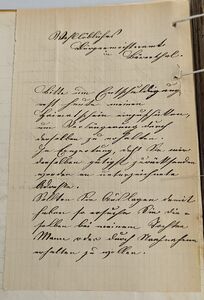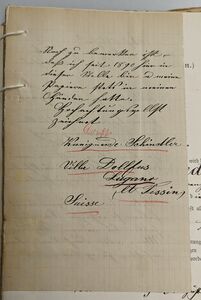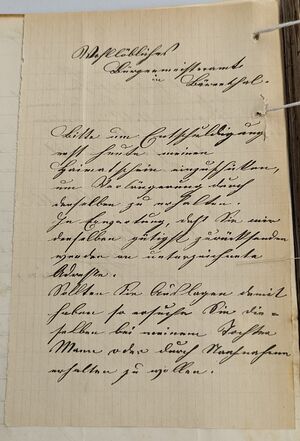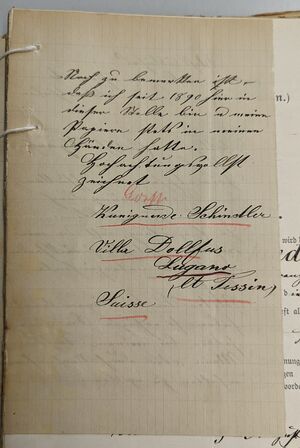Contents |
Biography
Kunigunda Schindler was born on 14 August 1840 in Hinterzarten to the sawyer (Säger) Andreas Schindler and his wife Adelheid Schelb. Her godparents were Johann Schelb and Maria Schindler, both single and probably siblings to her parents.[1] The family lived in Hinterzarten until 1849, when Andreas became innkeeper of the 'Adler' in the neighboring village of Bärental and the whole family relocated there.[2]
After the 'Adler' was auctioned off in 1856, because Andreas had apparently gone bankrupt,[2] Kunigunde's parents split up and in the following year had their possessions separated. The separation agreement mentioned Kunigunde being 16 years of age and in service, meaning that there was was no longer an obligation on her parents to provide for her. This was not supposed to be changed ("davon bedarf aber vorderhand Kunigund Schindler auch keinen Aufwand, da sie dient und soll vorderhand ihr Zustand in dieser Beziehung der bisherige bleiben").[3]
On 1 August 1866 she gave birth to an illegitimate daughter named Maria Schindler in Hinterzarten.[4] In November 1866 she requested a certificate of residence (Heimatschein) for Maria from the local council of Bärental.[5]
Nine years later, in the summer of 1885, Kunigunda requested such a certificate for herself. According to the local council's report, she planned to take up work in Neuchâtel, Switzerland. The report regarding the application also mentioned her passport and gave a birth date of 26 August 1840, which was 12 days out as compared to the church record.[6]
In 1890, after the usual five years, her Heimatschein expired and needed to be renewed. The report about her renewal request stated that she had been working in Castagnola for a longer period ("ist schon längere Zeit in Castanolla [sic] in Dienst"), Castagnola being a city near Lugano in the Swiss Canton of Ticino/Tessin, about 260 km away from Neuchâtel. Besides the same wrong birth date, the report contained a personal description instead of a reference to her passport. Both her hair and her eye color were given as grey, her face was described as round and her body type was besetzt, which may have meant something similar to untersetzt (rather small and well nourished).[7]
In 1895 another prolongation was required, for which she applied with a handwritten letter sent from Villa Dollfus in Lugano, including the previous certificate from 1890.[8] At one point the birth date, which was initially written wrongly again, was corrected, until she also handed in this document five years later, in 1900.[9]
Her entry in Castagnola's register of foreigners from 1900 listed her together with another woman (Maria Ermann, maybe supposed to be Hermann) from the Grand Duchy of Baden as living with the Dollfus family. Her name was given as Schindler Nina.[10] The name Kunigunde was probably too difficult for Italian speakers to pronounce, resulting in it being changed to 'Nina'.
The report about her Heimatschein from December 1900 did not seem to contain any new information, unlike the one from October 1905: according to the form she was a maid (Dienstmagd) living in Switzerland, who was widowed. The fee for the issuing of the Heimatschein, which did not contain this incorrect marital status, was paid by her son-in-law Josef Hercher.[11]
In her request for a further prolongation in October 1910, she was once again said to be single, living in "Lugano Tessin Schweiz". Her occupation differed from the previous form, being given as a "person in service" (Dienstperson). She again requested the document be sent to her son-in-law.[12] All these papers had in common that they claimed she was born in Bärenthal, when she was actually born in Hinterzarten.
Research notes
Maria's father
Family lore claims that Maria's father was the Swiss painter Frank Buchser.[13][14] Maria was said to have told her son Emil Hercher that Buchser was her father when she saw something about him in a newspaper.[14] Emil was reported to have mumbled something about him being his grandfather when there was a report about Buchser on the radio.[13]
Some in the family assumed that Frank Buchser was in Baden at the time of conception and may later have helped Kunigunde to find a job in Switzerland.[13] Others claimed that Kunigunde was already working abroad when she met Buchser. It was said that she was allowed to deliver the child at home in Baden, but then had to leave her behind in order to be able to continue working in Switzerland.[14]
From today's perspective, the situation for illegitimate children and their mothers in Switzerland was catastrophic: if the father did not acknowledge paternity, the child could be taken away from the unmarried mother.[15][16]
With this background, it would be understandable that Kunigunda would have chosen to return to the Black Forest for the birth of her child and that she would not have been able to take Maria to Switzerland upon her return there.
- to do: maybe that's why Maria also left the child at home?
Meeting Buchser in the Black Forest?
- to do: reconstruct where Buchser was in October and November 1865 (calculated conception would be 1 November 1865)
Meeting Buchser in Switzerland?
The first known request for a Heimatschein by her only dates back to 1885, when she requested the one for Neuchâtel.[6] In the file containing Heimatschein requests for Bärenthal from 1855 until 1873[5] as well as in the the one from 1874 to 1894,[6] there is no earlier request found from her, except the one for her daughter in 1866.[5]
This suggests that she was either not working abroad before 1885 or that she was, but without actually requiring such a document. A Heimatschein was intended either for staying in one place over a longer time period or for the purpose of working as a servant/maid or day laborer - both usually outside of Baden ("... auf einen bestimmten Ort und auf einen längeren ununterbrochenen Aufenthalt daselbst lauten, oder sollen nur zum Zweck des Dienens, also nur an Dienstboten und Taglöhner erteilt werden."). Passports and further documents were used for travel other for other purposes.[17]
Kunigunda's older sister Maria Schindler requested a Heimatschein for Basel in 1862,[18] gave birth to a child in Freiburg at the end of that year and apparently left the child in Baden around 1864 (maybe for the reasons mentioned above?), before giving birth to her second child, again in Freiburg, at the end of 1867 and wanting to work in Sarnen, Canton Obwalden, starting in April 1868.[19] This time between 1864 and 1867 would perfectly cover the calculated time of conception of Kunigunda's child around 1 November 1865. Maybe Kunigunda was with her without needing a Heimatschein e.g. on a longer visit or similar.
- to do: learn about Basel civil registration and treatment of foreigners
- to do: do something with https://www.fedlex.admin.ch/eli/fga/1863/3_821__/de
Wild theory: Maria Schindler might have worked for some person from or close to the wealthy Burckhardt family from Basel. Via his wife Annie Elisabeth Burckhardt, there would have been a connection to Roger Albert Dollfus, the son of Kunigunde's later employer. Julia Burckhardt, a relative of Annie Elisabeth on the other hand, was married to Christof Socin, who exchanged several letters with Frank Buchser between October 1881 and September 1887 (the year before Socin's death).[20] The two Burckhardt women were third cousins once removed.[21]
Also Gaspard Dollfus, the grandfather of Roger Albert Dollfus, was living in Rebgasse 1 in Basel in 1868.[22]
Unfortunately searches of the State Archives of Canton Basel-Stadt did not turn up any information on Kunigunda or her sister Maria in the following collections:
- Bürgerrecht G 2.16
- Adressbuch der Stadt Basel
- PD-REG 7-1 (Einwohnerkontrolle)
- JD-REG 6e 2 5 (Trauungen, 1701-1869, L-Schlh)
- JD-REG 6e 1 35 (Taufen, 1801-1869, Sch-So)
Working abroad
At one point Kunigunda's daughter Maria was being raised by foster parents (or similar) who lived at Schniederpauli's.[13] Her mother was apparently able to visit her daughter once a year. In the earlier years she is reported to have come by coach, later by train through the Gotthard Tunnel, which was opened in 1882.[14] This may imply that she was either working in one place over a longer period and was only able to use the tunnel after it was built, or that, in the earlier years, she worked somewhere in Switzerland from where the journey did not require her to cross the Saint-Gotthard Massif.
The church family register of Hinterzarten, which was started around 1870, has her working in Switzerland (dient in d. Schweiz).[23]
- to do: try to determine when the church family register was no longer updated in order to see at least how old this information was
In 1875, ten years before Kunigunda requested her first Heimatschein for Switzerland, her younger sister Caroline Schindler was already working in Neuchâtel.[24] Maybe Kunigunda had been there previously or got the job via her sister. Neuchâtel was only 60 km away from Buchser's home in Solothurn …
In spring 1878 their brother Paul Schindler planned to work in Kriens, Canton Luzern, Switzerland.[25] In 1881 or 1882 Maria's daughter, Kunigunda's niece, died in Luzern.[26]
It looks like the siblings were sometimes quite close to each other in this foreign country.
The State Archives of the Canton of Neuchâtel have records of Caroline being there in the 1870s, but no sign of Kunigunda. The State Archives of the Canton of Ticino do not have Kunigunda recorded in the Register of Population kept between 1878 and 1901, as well as at the three registers kept from 1904 to 1935. The is also not to be found within the 500 families that lived in Castagnola between 1878 and 1901.[27]
Villa Dollfus, where she had already been working in 1890,[7] is situated in Castagnola (currently: part of Lugano) on the shore of Lake Lugano. It was constructed between November 1887 and when the family moved in on 10 October 1889.[28]
Her occupation is said by some members of the family not to have been housework, but mainly entertaining visitors,[13] while others claim she was very hard-working and in the end became the Beschließerin (a housekeeper in the historic sense of the female head of the indoor servants).[14]
- How did she get there?
- Is there a documented relationship between the Buchser and Dollfus families?
Death
Time
It is said that she wanted to spend her old age at Ramselehof with her daughter's family. She apparently offered them the money to build a chimney, but Joseph Hercher, Maria's husband, is reported to have said that his mother had always cooked in the smoke kitchen (Rauchküche) and therefore refused to have the house modernized. Kunigunde's years of service had acquainted her with a higher level of comfort and she chose to remain where she was.[14]
Kunigunde's legacy was in booked Swiss francs and was to be picked up from the Basler Kantonalbank. When she died, the value of the Goldmark had dropped dramatically (probably during Hyperinflation in the Weimar Republic between 1921 and 1923). Maria, her daughter, went to the bank and received a pile of nearly worthless German inflation money. Four big suitcases with quite exquisite clothing - at least from the perspective of people living on a Black Forest farm - arrived by post. Among them were multiple pairs of glacé gloves.[13]
The obituary of Kunigunda's brother Joseph, who had emigrated to the US in the 1870s and who died on 13 February 1923, stated that he was survived by three sisters in Germany.[29] This might help to narrow down the death dates of Kunigunda and her four sisters, once the death dates of at least two of them have been found. One of course also needs to take into consideration that news would take some weeks to arrive in the US.
- to do: find the deaths of her sisters
The Bärenthal Heimatschein files do not contain any request from Kunigunde from October 1910 until the end of 1920.[12] In theory she would have needed another prolongation in 1915, which may have been postponed because of the Great War. On the other hand, she may not have needed one as she would have been 75 years of age and perhaps in receipt of some kind of pension).
- to do: check Heimatschein file from 1923-1929
A chimney was built at Ramselehof in or around 1927, certainly after the death of Maria Schindler's husband Joseph Hercher.[30] Oskar Hercher, Maria's grandchild, always wondered where the money had come from. One theory was that it was financed by the inheritance from Kunigunda.[13] However, since that money was reportedly nearly worthless – Maria's grandchild Ludwig Steurenthaler later used inflation money as wallpaper for his party room[13] – this was rather unlikely.
Place
On a visit to Lugano in the 1960s, her great-grandchild Steurenthaler-1 met a neighbor who said she had known Kunigunde (or the Dollfus family?) and that she (or they?) had moved to Lake Thun.[13] This refers to Ruggero Dollfus (aka Roger Albert Dollfus de Volckersberg, * 14 July 1876 in Milano), who bought Kiesen Castle in 1915 and died there in 1948.[31] Kiesen is about 10 km away from Lake Thun.
- Did Kunigunde maybe move to Kiesen?
- to do: ask cemetery administration of Wildtrach
- to do: ask civil administration about registration documents
- Who took over the mansion in Castagnola?
Apart from Kiesen, The Register of Swiss Surnames, which "offers a comprehensive alphabetical listing of all the families holding citizenship in a Swiss community" as of 1962, also lists a Dollfus family in Basel, who obtainted citizenship in 1900.[32]
- Did she maybe work for the Dollfus family in Basel towards the end of her life and die there? It might explain why the money was at the Bank of the Canton of Basel, which did not exist in other Cantons.
The death record of her daughter Maria from January 1948 gives her mother as "Kunigunde Schindler, zuletzt in Lugano" (lastly in Lugano),[33] which implies that she might have gone to neither Kiesen nor Basel, but died in Castangola or close by.
Support for this theory came in March 2023 with an email from a grandchild of Roger Dollfus, who claims that Kunigunde is buried with the Dollfus family! Since even Roger Dollfus, who passed away in Kiesen, was buried in Castagnola,[34] this grave must have been (and maybe still is) in the village of Kunigunda's former workplace.
Revolver
According to family lore she owned a small revolver, which she may have received after Buchser's trip to the United States. Apparently her daughter Maria used to carry it in her apron after Kunigunda's death. It is not known what happenend to it after Maria's death.[35]
There was an incident when Maria almost shot her son Wilhelm with a revolver at Ramselehof, because she mistook him for a burglar. Steurenthaler-1 claims that Maria received that gun from her son Emil, who was a forester.[36] Maybe this was actually the gun from Kunigunda?
Ideas for further research
- Politisches Archiv des Auswärtigen Amts
- Dollfus in Viganello
- Dollfus in Kiesen -> ask State Archive of Canton Berne about her
Acknowledgements
- I. Caruso for mapping "Lake Thun" with "Kiesen Castle"
- Friedrich R. Wollmershäuser for pointing me towards Heimatschein documents
- Numerous authorities that searched for records of her
Sources
- ↑ "Germany, Baden, Archdiocese of Freiburg im Breisgau, Catholic Church Records, 1678-1930". Citing Baptism, Hinterzarten, Neustadt, Baden, Deutschland, , Erzbischöfliches Archiv Freiburg (Archbishop's Archives), Germany. FamilySearch (accessed 27 February 2022) FamilySearch Image Image number 00769. Kunigunda Schmidler baptism on 14 Aug 1840 in Hinterzarten, Neustadt, Baden, Deutschland.
- No 17.
- Im Jahr achtzehn hundert u. vierzig
- am vierzehnten? August früh drey
- Uhr wurde dahier geboren und
- heute Nachmittag drey Uhr getauft:
- Kunigunda; ehel. Kind des hiesigen?
- Bürgers und Sägers Andreas
- Schindler und der Adelheid Schelb.
- Zeugen sind der ledige Johann Schelb
- mit der ledigen Maria Schindler
- und Meßmer Joh. Georg Hensler
- sämtlich dahier.
- Hinterzarten am 15. August 1840
- ↑ 2.0 2.1 August Vetter: Geschichte der Gemeinde Feldberg (1968), p. 476 (transcript at her father's profile)
- ↑ Landesarchiv Baden-Württemberg, Staatsarchiv Freiburg, G 550/1 Nr. 4441, Vermögensaufnahme und Absonderung zw. Schindler, Andreas und Ehefau Adelheide geb. Schelb, Bärental], p. 3 and 12
- ↑ "Germany, Baden, Archdiocese of Freiburg im Breisgau, Catholic Church Records, 1678-1930". Citing Baptism, Hinterzarten, Neustadt, Baden, Deutschland, , Erzbischöfliches Archiv Freiburg (Archbishop's Archives), Germany. FamilySearch (accessed 27 February 2022) FamilySearch Image Image number 00107. Maria Schindler baptism on 1 Aug 1866 in Hinterzarten, Neustadt, Baden, Deutschland. (see Schindler-1412 for transcript)
- ↑ 5.0 5.1 5.2 Landesarchiv Baden-Württemberg, Staatsarchiv Freiburg, B 726/1 Nr. 5145, Ausstellung von Heimatscheinen für in der Gemeinde Bärental Heimatberechtigte 1855-1873, 18 November 1866, 10206
- ↑ 6.0 6.1 6.2 Landesarchiv Baden-Württemberg, Staatsarchiv Freiburg, B 726/1 Nr. 5146, Ausstellung von Heimatscheinen für in der Gemeinde Bärental Heimatberechtigte 1874-1894, 7361/No. 198
- ↑ 7.0 7.1 Landesarchiv Baden-Württemberg, Staatsarchiv Freiburg, B 726/1 Nr. 5146, Ausstellung von Heimatscheinen für in der Gemeinde Bärental Heimatberechtigte 1874-1894, 10958/No. 216
- ↑
Landesarchiv Baden-Württemberg, Staatsarchiv Freiburg, B 726/1 Nr. 5147, Ausstellung von Heimatscheinen für in der Gemeinde Bärental Heimatberechtigte 1895-1905, 19458?:

front - Wohllöbliches
- Bürgermeisteramt
- in Bärenthal
- Bitte um Entschuldigung
- erst heute meinen
- Heimatschein einzuschicken,
- um Verlängerung durch
- denselben zu erhalten.
- In Erwartung, daß Sie mir
- denselben gütigst zurücksenden
- werden an unterzeichnete
- Adresse.
- Sollten Sie Auslagen damit
- haben so ersuche Sie die=
- selben bei meinem Tochter
- Mann oder durch Nachnahme
- erhalten zu wollen.//

back - Noch zu bemerken ist,
- daß ich seit 1890 hier in
- dieser Stelle bin u. meine
- Papiere stets in meinen
- Händen hatte
- Hochachtungsvollst
- gezeichnet
- Kunigunde? Schindler
- Villa Dollfus
- Lugano
- (Ct. Tessin)
- Suisse
- ↑ Landesarchiv Baden-Württemberg, Staatsarchiv Freiburg, B 726/1 Nr. 5147, Ausstellung von Heimatscheinen für in der Gemeinde Bärental Heimatberechtigte 1895-1905, 24341
- ↑ Controllo abitanti, Registro delle notifiche degli stranieri 1898-1905, registro 15, 1900/11
- ↑ Landesarchiv Baden-Württemberg, Staatsarchiv Freiburg, B 726/1 Nr. 5147, Ausstellung von Heimatscheinen für in der Gemeinde Bärental Heimatberechtigte 1895-1905, 21866/No. 435
- ↑ 12.0 12.1 Landesarchiv Baden-Württemberg, Staatsarchiv Freiburg, B 726/1 Nr. 5148, Ausstellung von Heimatscheinen und Staatsangehörigkeitsausweisen für in der Gemeinde Bärental Heimatberechtigte 1906-1920
- ↑ 13.0 13.1 13.2 13.3 13.4 13.5 13.6 13.7 13.8 told like this by Steurenthaler-1 to Florian Straub
- ↑ 14.0 14.1 14.2 14.3 14.4 14.5 Story told by Kunigunde's grandchild Maria Hercher to one of her grandchildren.
- ↑ Mirjam Häsler, Niemandskinder, Schweizer Monat, Ausgabe 968, März 2009 [1]
- ↑ Karin Grütter, Kindstötung im 19. Jahrhundert: Armut contra bürgerliche Moral (1988) [2]
- ↑ Die Polizeigesetzgebung des Großherzogthums Baden, 1853, p. 378 f. (Google Books)
- ↑ Landesarchiv Baden-Württemberg, Staatsarchiv Freiburg, B 726/1 Nr. 5145, Ausstellung von Heimatscheinen für in der Gemeinde Bärental Heimatberechtigte 1855-1873, 7 July 1862, 4453
- ↑ Landesarchiv Baden-Württemberg, Staatsarchiv Freiburg, B 726/1 Nr. 5145, Ausstellung von Heimatscheinen für in der Gemeinde Bärental Heimatberechtigte 1855-1873, 1868/69, 10145
- ↑ Search results at kalliope-verbund.info
- ↑ WikiTree Connection Finder (accessed 23 August 2022)
- ↑ Adressbuch der Stadt Basel von 1868, p. 37 (Scan)
- ↑ Familienbuch der Pfarrei Hinterzarten, p. 71b., FHL microfilm 923138, image 368
- ↑ Landesarchiv Baden-Württemberg, Staatsarchiv Freiburg, B 726/1 Nr. 5146, Ausstellung von Heimatscheinen für in der Gemeinde Bärental Heimatberechtigte 1874-1894
- ↑ Landesarchiv Baden-Württemberg, Staatsarchiv Freiburg, B 726/1 Nr. 5146, Ausstellung von Heimatscheinen für in der Gemeinde Bärental Heimatberechtigte 1874-1894
- ↑ Landesarchiv Baden-Württemberg, Staatsarchiv Freiburg, B 726/1 Nr. 5146, Ausstellung von Heimatscheinen für in der Gemeinde Bärental Heimatberechtigte 1874-1894, 26 January 1882
- ↑ Reply to request to State Archives of the Canton of Ticino in June 2023
- ↑ Villa Dollfus in Castagnola bei Lugano: Architekt: F. Kühn In: Verlags-AG der akademischen technischen Vereine (Herausgeber): Schweizerische Bauzeitung, Band 23/24 (1894), Heft 20, 19 May 1894, p. 128, scan
- ↑ Joseph Schindler Dies, The Pittsburgh Press, 14 February 1923, p. 20, newspapers.com
- ↑ Gemeinde Hinterzarten: Sterberegister 12/1924. Todeschein. 8 January 1828
- ↑ Gemeinde Kiesen - Ortsgeschichte, kiesen.ch
- ↑ The Register of Swiss Surnames, Historical Dictionary of Switzerland
- ↑ Standesamt Hinterzarten, Sterberegister 1/1948
- ↑ Death announcement Roger Dollfus, Neue Zürcher Zeitung, Nummer 1491, 14. Juli 1948, e-newspaperarchives.ch
- ↑ told like this by Maria's great grandchild W. Hercher on 27 July 2022
- ↑ told by Steurenthaler-1 on 19 October 2014
No known carriers of Kunigunde's DNA have taken a DNA test.
Have you taken a DNA test? If so, login to add it. If not, see our friends at Ancestry DNA.
Featured National Park champion connections: Kunigunde is 23 degrees from Theodore Roosevelt, 26 degrees from Stephanus Johannes Paulus Kruger, 24 degrees from George Catlin, 27 degrees from Marjory Douglas, 33 degrees from Sueko Embrey, 27 degrees from George Grinnell, 34 degrees from Anton Kröller, 25 degrees from Stephen Mather, 27 degrees from Kara McKean, 29 degrees from John Muir, 27 degrees from Victoria Hanover and 36 degrees from Charles Young on our single family tree. Login to find your connection.
S > Schindler > Kunigunda Schindler
Categories: Canton de Neuchâtel | Canton of Neuchâtel | Switzerland Family Brick Walls | Hinterzarten, Baden-Württemberg | Bärental, Baden-Württemberg | Switzerland, Immigrants | Castagnola, Ticino


Grüße von Eva.
Good Job saving this part of history that may have been lost.
was missing from Clausthal church records between 1709 and 1715 in Clausthal . Not much chance you would have any information that he might have heade north to Clausthal from the Black Forrest. But if you see anything like that let me know. More than likely he moved from another area of Hanover to Clausthal, but folks back then can surprise you how far they travelled.
edited by MiKe Schindler